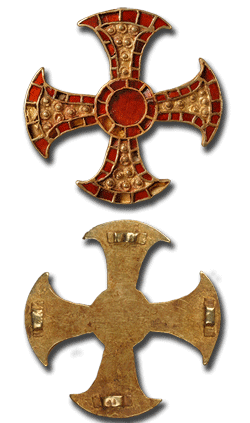
(Courtesy University of Cambridge)
WHAT IS IT?
Pectoral in the shape of a cross
DATE
7th century A.D.
MATERIAL
Gold and garnet
DISCOVERED
Trumpington Meadows,
Cambridgeshire, England
SIZE
1.4 inches in diameter
At a time when Christianity was first starting to take root in England, a
teenage girl was buried still wearing the stunning gold and jeweled cross
she had sewn to her clothing during her short life. She was laid to rest on
an ornamental bed covered with a straw mattress, where she remained
for more than 1,300 years, preserving evidence not only of the extremely unusual practice of bed burial, but also of her high status and her faith. In fact, the girl's grave is one ofthe earliest Anglo-Saxon Christian burial sites in Britain. It dates from a brief period—a century at most—when particular traditions of pagan religion, such as the bed burial and the inclusion of grave goods, coexisted with the Christian belief in the continuation of the soul, but not the body, after death.
According to Alison Dickens of Cambridge University, who led the excavation, to find a bed burial is remarkable—only 15 have been uncovered in the United Kingdom—but to find one in combination with a gold pectoral cross, of which there are only five known, is extraordinary. "We think
there's only been one other such burial, which was found in nearby Suffolk," explains Dickens, "but it was uncovered in the nineteenth century and the records are very unclear." With the application of modern scientific techniques, archaeologists hope to tell more of the girl's story. "The mysteries of who she was, why she was here, and why her
grave merited such lavish treatment," says Dickens, "have certainly
captured our imagination!"

